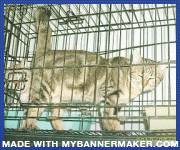The Flemish Giant is a popular breed of domestic rabbit, most famous for its large size compared to other rabbits. The Flemish Giant has a minimum weight of 5 kg, and can live for up to five years or more.
History
The origins of the Flemish Giant rabbit are uncertain. It is believed that the Flemish Giant rabbit is the modern descendant of the Patagonian rabbit of Argentina which was brought to Europe by 16th and 17th century Dutch traders. The large rabbits of Flanders were well known at the time, and may have been cross bred with the Patagonian. While the name "Flemish" comes from Flanders, the similarities to the Patagonian lead many to speculate that this giant is in fact descended primarily from the wild Argentine rabbits. This is highly unlikely, because the only native rabbits in Argentina, the tapeti (Sylvilagus brasiliensis) weighs less than two pounds[1] (about 1 kg). The Patagonian hare (Dolichotis patagonum), also known as the mara is a variety of rodent and thus cannot interbreed with European rabbits.[2]
However, opponents of this theory point out the Argentina Patagonian rabbit is actually classified as a Cavy and association with the Flemish Giant is very doubtful. Instead, it is argued that the Flemish is a line descended from a number of giant breeds from the old Flemish region, possibly including the Steenkonijn (Stone Rabbit) and the European "patagonian" breed (now extinct).[3] An alternative hypothesis is that near the end of the 19th Century, the Flemish Giant as we know it today was developed in eastern Europe, and the first standards for the breed were written by Albert Van Heuverzwijn in the Netherlands 1893[3]. On the other hand, Wilkins (1896) wrote that the Flemish Giant was developed from the Leporine imported into England in the middle 1800s and shares its ancestry with the Belgian Hare.[3]
The Flemish Giant was imported from England and Belgium to America in the early 1890s. It received no special attention until about 1910 where it started appearing at small livestock shows throughout the country. Today, it is one of the more popular breeds at rabbit shows because of its enormous size and its many colors. It is promoted by the National Federation of Flemish Giant Rabbit Breeders which was formed in 1916.
Appearance
As one of the largest breeds of domestic rabbit, the Flemish Giant is a semi-arch type rabbit with its back arch starting back of the shoulders and carrying through to the base of the tail giving a "mandolin" shape. The body of a Flemish Giant Rabbit is long and powerful with good muscular development and relatively broad hindquarters. Bucks have a broad, massive head in comparison to does. Does may have a large, full, evenly carried dewlap (the fold of skin under their chins). The fur of the Flemish Giant is known to be glossy and dense, and when stroked from the hindquarters to the head, the fur will roll back to its original position. ARBA standard has seven different colors, black, blue, fawn, light gray, sandy, steel gray and white. They are shown in six classes (three buck classes and three doe classes): Junior bucks and does under 6 months, Intermediate bucks and does 6–8 months, and Senior bucks and does 8+ months. The minimum show weight for a Senior (older than 8 months) doe is 14 lbs (about 6.4 kg), and the minimum weight of a Senior buck is 13 lbs (about 5.9 kg)(ARBA Standards of Perfection). As with other "giant" breeds, the Flemish Giant grows slowly. A senior doe can take 1 year to reach full maturity. A senior buck can take 1.5 years to reach full maturity. It is not unusual to see a 10 kilo (22 pound) Flemish Giant, and specimens weighing 13 kilos (28 pounds) have been reported.
Behaviour & Lifestyle
Flemish Giants are known to be quite placid and laid-back, and as a result, they are known to be docile and tolerant of considerable handling, but could become fearful if handled incorrectly or irresponsibly, and for this reason it is generally recommended that it be under the care of an experienced or mature owner.
Due to its large size, the Flemish needs a large space to roam around. The House Rabbit Society, an international nonprofit rabbit rescue organization, recommends keeping your rabbit inside the home; in a very large pen or room(s) in the home. Some rabbits use litter boxes due to instinct or after observing cats and other rabbits do so. Rabbits using litter boxes may safely have run of the home, provided adequate protections are in place for safety. The Flemish Giant will require more food compared to other breeds of domestic rabbit (many cups per day). Unlike other breeds, the Flemish Giant will only require mild attention to grooming due to its short-hair. It does molt (lose old coat) in Spring and Fall. Some grooming at that time will keep your Flemish Giant looking nice, and feel better.
Diet
Like the majority of rabbits, the most important component of the diet of a Flemish Giant is hay, a roughage that reduces the chance of blockages and malocclusion whilst providing indigestible fiber necessary to keep the gut moving. Grass hays such as timothy are generally preferred over legume hays like clover and alfalfa (lucerne). Legume hays are higher in protein, calories, and calcium, which in excess can cause kidney stones and loose stool. This type of hay should be reserved for young kits or lactating does. A good quality rabbit feed (16-18% protein) is fine for Flemish Giants, as long as they have some supplement feed. A mix of black sunflower seed, beet pulp, steam rolled barley, shelled corn, in equal parts is a good winter mix.
It is recommended that the Flemish Giant, like other rabbits, receive a standard intake of 2 cups of chopped dark, green, leafy vegetables per 6 pounds (3 kg) of body weight (although this should be provided after four months of age to prevent enteritis) and up to 2 tablespoons of fruit or carrots per 6 pounds of body weight daily. It is common for some owners to provide treats, although in very limited quantities, which can include a few pellets, a slice of strawberry,banana, apple or other healthy foods. Commercial treats are available in the pet stores in shops and can be occasionally used, although even more sparingly, since they typically feature a higher sugar and starch content.
Some of the vegetables that rabbits enjoy are romaine lettuce, escarole, turnips, collard, kale, parsley, thyme, cilantro, dandelion, and basil. The green, leafy tops of radish and carrots also are excellent sources of nutrients—more than the vegetable itself. New vegetables should be introduced slowly due to the delicate digestive systems of rabbits. It is recommended that cauliflower, broccoli and cabbage be avoided, as they cause gas and can lead to gastrointestinal stasis, which can be fatal. Vegetables such as potatoes should also avoided due to their high starch content. The Flemish Giant will also require an unlimited amount of fresh water, usually provided for in a water crock, tip-proof ceramic pet dish, or hanging water bottle.
Sexing
The ideal age for the female Flemish Giant rabbit to start breeding is when they are about 9 months to one year.[4] The first litter should be born before the female is one year old, due to fusing of the pelvic bones[4], that would hinder her ability to give birth naturally. It is prefereable that they have no more litters after the age of three years. The gestation period is between 28–31 days[4]. On average they give birth at 30–32 days. The Flemish Giant rabbit can produce large litters, usually between 5 to 12 in a litter[4].
















No comments:
Post a Comment